#127 Postcards from unknown soldier
Postcards from unknown soldier
by Sandi Ratch
First published May 2, 2017
*
Faced with a handful of family postcards signed only by “Dick,” Sandi Ratch gave herself a detective quest: to identify the messenger who had gone to continental Europe to fight in World War I.
In this Ormsby exclusive, Sandi Ratch relates the specifics of her search, leading her to conclude “Dick” was one of the 3,598 Canadian lives that were lost at the Battle of Vimy Ridge between April 9 and 12, 1917.
That battle one hundred years ago terminated productive careers in every corner of Canada, produced a paper trail of military records and dry genealogy, and generated submerged shoals of memory or grief in almost every community. – Ed.
*
By Sandi Ratch
My great-grandparents, like many people of their generation, collected postcards. My grandmother had them, and then they came to me. There are about 100 of them dating between 1909 and 1920. I’ve been in love with them my whole life. A few years ago, with a Master’s Degree in Historical Archaeology and years of history research experience in hand, the postcards began calling to me and I began getting serious about researching them.
Six of the postcards stood out as a related group. They were all from a month in the fall of 1915, all signed “Dick,” and they indicated a journey across Canada during World War One. I knew very few of the names of my great-grandparents’ friends. Maybe one, actually, and it wasn’t “Dick” or “Richard.” My curiosity was piqued and I went on what I thought was a futile quest to try and find something out about this man.
From the postcards, which I describe below, I could only glean that he was a soldier with the 47th Battalion Canadian Expeditionary Force (C.E.F.), and that he was the friend of many members of my family. His messages provide no further details about his full name, let alone his origin, his occupation, or his fate.
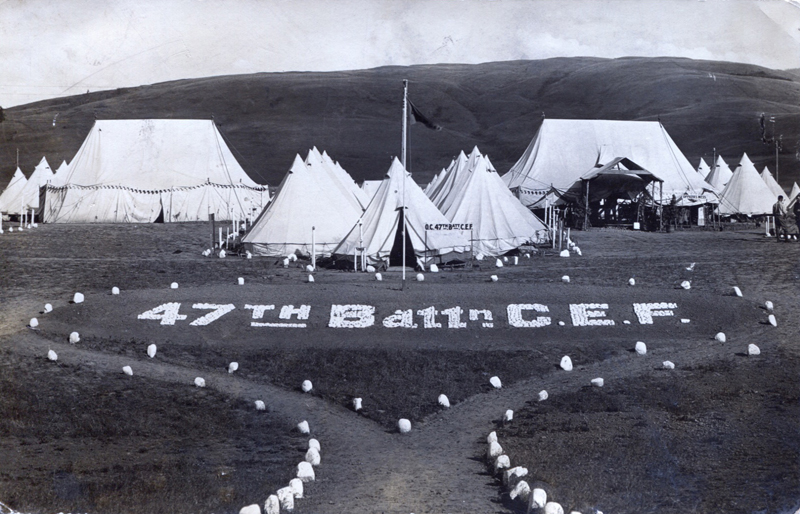
The first postcard from Dick pictures the tents of the 47th Battalion at Vernon Army Camp, known as a concentration camp or military training camp in those days. It was postmarked from there on October 25th, 1915.
The Vernon camp had been established in 1912 as a permanent annual district summer training camp for both infantry and militia units. It became a central mobilization camp and training centre in 1915, and by 1916, 7,000 men were training at the centre — while Vernon barely had a population of 3,000.[1] The Army Camp has been an important feature in Vernon for over 100 years.
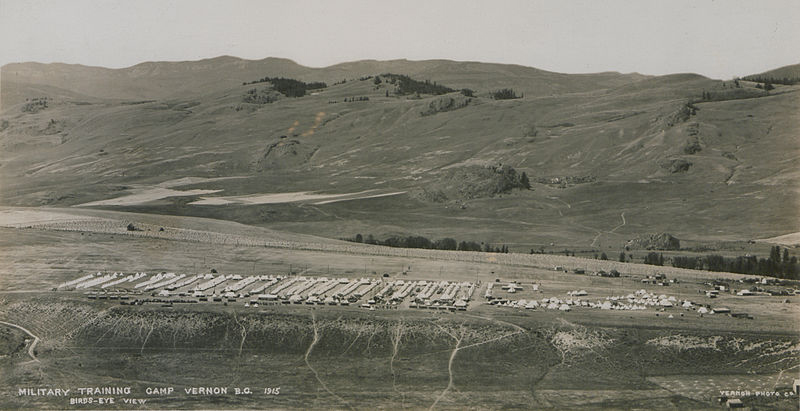
Written to my great-grandfather, Jack McCurrach,[2] the text on the back of the postcard reads: “Dear Jack We are leaving here on the 26th for New Westminster if all goes well.” From the postcard we conclude that Dick was a soldier in training with the 47th Battalion. They were at the Vernon Camp doing the normal summer training that couldn’t be done in their New Westminster barracks.
They practiced manoeuvring in makeshift trenches, bayonet and rifle drills, and various other types of training, and practiced being mobile in tent camps — all necessary skills on the front lines, although the training was rarely sufficient for the task ahead. Several battalions from mainland British Columbia trained at the Vernon Camp during World War One.[3]
In late October 1916, when they were headed west from Vernon to New Westminster, the battalion probably did not know they were going to head to Europe in such short order.
October would normally have been the time for the Battalion to pack up from the summer tent camp in the Okanagan and move back to the barracks in New Westminster. There they would settle in to regular barracks life until their call came up or it was time to move back to summer training camp. Apparently the call came very quickly.
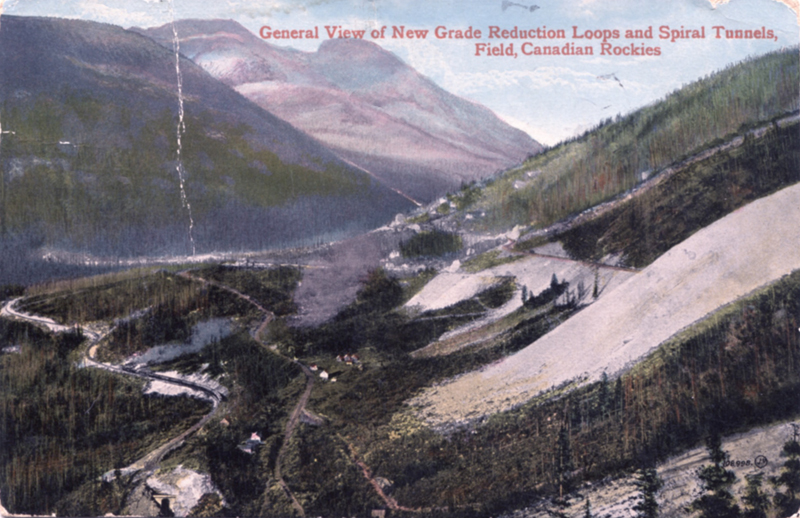
The second postcard shows a fascinating engineering feat of the times: “A General View of New Grade Reduction Loops and Spiral Tunnels, Field, Canadian Rockies.” The two spiral tunnels were a solution to steep grades going through the Rockies and had been built only six years before Dick travelled through them.
On this particular postcard, the stamp and postmark have been all but torn off, so we can’t know exactly where Dick mailed it, although it was somewhere between the B.C. Coast and Regina, Saskatchewan, where he mailed the next one.
But the date is legible, either 8th or 9th November 1915. Sent again to my great-grandfather, Dick’s patriotic text on the back reads: “We are on our way to Berlin everyone happy Dick.” Surely by this time, the men knew that they were walking into trench and gas warfare. Were they really happy and excited to go into this challenge, or was Dick covering up fear with bravado? This we will never know.
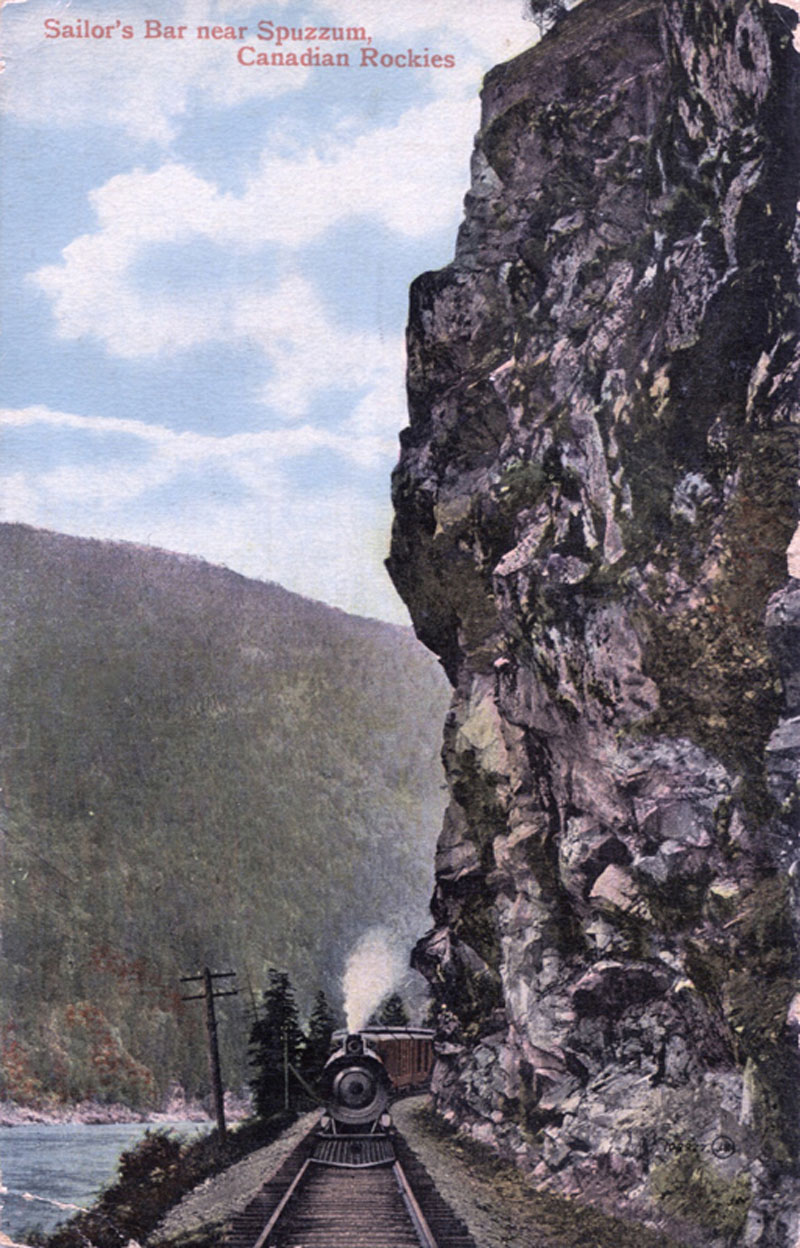
The third in this series of cards from Dick shows Sailor’s Bar near Spuzzum, B.C. It too is identified as “Canadian Rockies.” The postcard, of course, is wrong. Sailor’s Bar and Spuzzum are in the Fraser Canyon, which cuts through the Coastal Mountain range, not the Rockies.
Mailed from Regina on November 9, 1915, the card was addressed to Miss Bella McCurrach, Jack’s sister. The message reads: “On the train 9th Nov 15 Hello Bella how are you getting along. We are having a fine time with the girls all along the line the weather is a bit cold here but everyone is happy Dick.”

The fourth postcard was sent November 11 from Fort William (now part of Thunder Bay). The front of the card shows White’s Creek Bridge in the Fraser Canyon. White’s Creek, on the river’s west side near Spuzzum, may have had its name changed in the past 100 years because it is not on any current maps.
The White’s Creek bridge, with its handsome granite-dressed six-pier structure, can be found on several postcards with a simple Google search, and it was part of a series of railway features including “the four tunnels.” Again — a true engineering feat of the time.
The reverse reads: “Got to Winnipeg this morning. Met Bill and the wife, they were down at the station at 3 in the morning and we got in at 4. But we only had a few minutes with them the two of them is looking well. We are having a fine [or fun] time Dick.”
Although not mentioned in Dick’s postcards, between Fort William and their departure city of Quebec, the battalion stopped and paraded in Ottawa.

The Vancouver City Archives has a picture of the 47th battalion in formation in the capital in November 1915 (most likely November 12th). On the left is the iconic Victorian High Gothic style of the 1866 East Block of Parliament Hill where John A. MacDonald once had his office. On the right is the 1899 Second Empire style Langevin Block where the Prime Minister’s Office (PMO) is located today.
Such a visit must have helped boost morale in the battalion, as well as remind the men what they were fighting to protect.
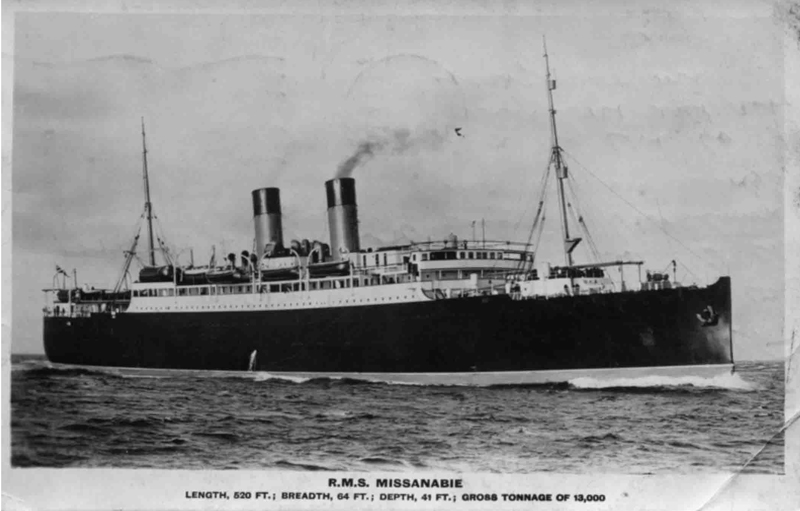
The last postcard Dick sent to the McCurrachs from Canada showed the ship the battalion would take to England: the R.M.S. [Royal Mail Ship] Missanabie. Mailed from Quebec City on November 13, 1915, this card was sent to Nellie McCurrach, my great-grandmother.
The reverse reads:
This is our boat we have got started allright (sic). started out on the 13th with a black crow on board. we had the crow on our train so we are allright (sic) give my love to everyone and kiss Gladys for me Dick.
Gladys, my grandmother, was about a year and a half old. I find it incredibly touching that Dick mentions her in his message. It is a tangible link to my own existence.
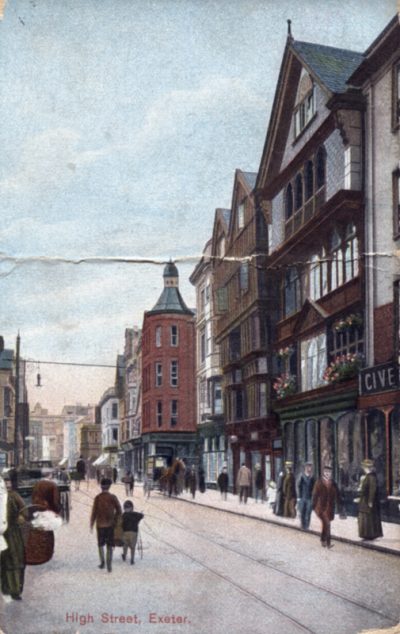
The final postcard from Dick in the collection was of High Street, Exeter, England, sent on November 24, 1915, two days short of a month from when Dick had left Vernon. It is postmarked “BRAMSHOTT CAMP P.O.”
The note on the back gives us our last glimpse of Dick’s life before the men of the 47th were transformed into fighting soldiers on the Western Front:
Dear Jack just a P.C. to let you know that we got across allright (sic) and are to be at Bramshott camp but the London is my address as we do not know how long we will be here. I do not know I will like this place as we can not … (?) Dick.
Bramshott was a large, temporary military camp southwest of London, England, in the Aldershot Command Area. It was used to temporarily house, train, and convalesce Canadian soldiers during the First and Second World Wars.[4]
*
With the information summarized above, how does one go about identifying the individual who sent them? I was lucky that the first postcard confirmed that Dick was with the 47th Battalion C.E.F. That gave me a place to start.
War records can be incredibly useful — as long as you know for certain that you have the right person. And just let me comment here that you cannot trust other people’s research, and the odds are that you are not related to that famous person with the same surname!
The first step was to identify the military group that perpetuates the 47th Battalion. Any battalion that is no longer in existence has its records maintained by a successor military group, and in this case the Royal Westminster Regiment perpetuates the 47th Battalion C.E.F.
I contacted the Royal Westminster Regiment by e-mail – that modern form of postcard communication. The man on the other end of the e-mail told me I was looking for a needle in a haystack. But I’m persistent.
It turned out that the Royal Westminster Regiment had recently published a history of its regiment (For King and Country: 150 Years of the Royal Westminster Regiment), including a list of all the men who went overseas with the 47th Battalion.[5] I couldn’t access a copy of the book where I live in Alberta, but a search online showed me that the Vancouver Public Library (VPL) had a copy.
Very kindly, my brother-in-law, Bruce, found the book in the VPL Reference Room and wrote down all of the Richards on that list. There were only ten, fewer than I expected from a relatively common name in a battalion of 1,000 men, but with that list in hand, the search was narrowing.[6]
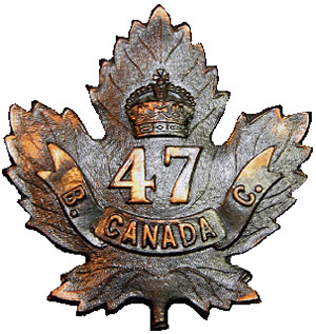 Library and Archives Canada (LAC) has a search engine called “Soldiers of the First World War.” It contains scans of the attestation papers (the sign-up papers that commit men to service) of most World War One soldiers from Canada. LAC is also in the process of digitizing soldiers’ records, some of which are now available online. The 47th Battalion had regimental numbers ranging from 628,001 to 630,000,[7] so I needed to find the men named “Richard” from the list who had regimental numbers in this range.
Library and Archives Canada (LAC) has a search engine called “Soldiers of the First World War.” It contains scans of the attestation papers (the sign-up papers that commit men to service) of most World War One soldiers from Canada. LAC is also in the process of digitizing soldiers’ records, some of which are now available online. The 47th Battalion had regimental numbers ranging from 628,001 to 630,000,[7] so I needed to find the men named “Richard” from the list who had regimental numbers in this range.
The first “Richard” on the list from Bruce was Richard Bell. I searched for that name using the LAC search engine and found there were 22 men with that name who served in WWI with Canada. Richard Bell, who departed with the 47th (regimental number 629030) was from Scotland, and he signed up in Vernon on July 3, 1915, so he was one possibility.
Next came Lieutenant-Corporal Richard Hoskins Duce – who had the only such name in the database, regimental number 629360 — but he was born in England and was living in Victoria when he signed up in New Westminster on March 18, 1915. I was pretty sure my Richard was Scottish — my great-grandparents seemed to stick with their fellow nationals. I didn’t think this was him, but I wouldn’t rule him out completely.
Then came the third name on Bruce’s list: “Richard Grant.” I found that nine Richard Grants went overseas from Canada in World War One. Regimental Number 629491 was Private Richard Grant, born in Inverness, Scotland. His mother is listed as living in Nairn, where my great-grandfather, Jack, lived for eight years with his family before immigrating to Canada. Grant’s birth date was March 19, 1885, making him the same age as Jack’s older brother, Alexander. Dick was taken on strength with the 6th Regiment, DCOR (Duke of Connaught’s Own Rifles) on August 25, 1915. He was then transferred to the 47th Battalion at the Vernon Camp on September 1.
Richard Grant listed his profession as “miner.”
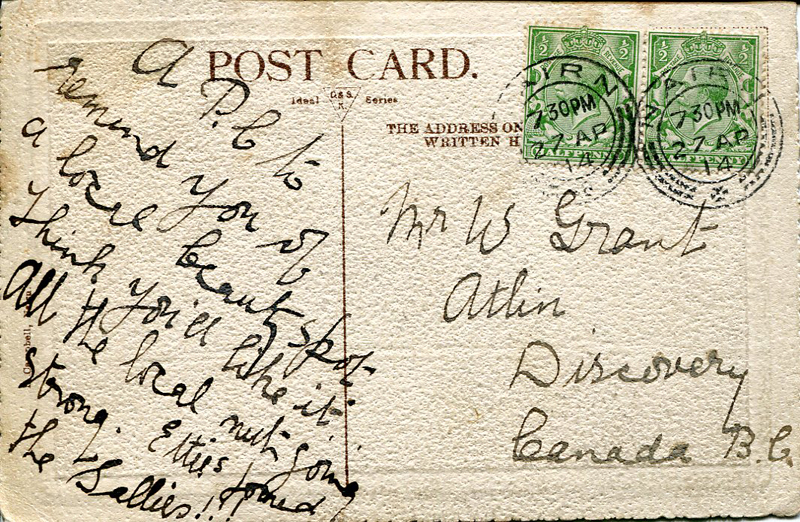
As I read this attestation paper something twigged — I had a postcard to a “W. Grant” in Atlin or Discovery, B.C., an offshoot of the Klondike gold rush in the province’s northwest corner.
Indeed, when I checked back to the census for Nairn for 1901, Richard Grant and his brother William were part of a family there. I then looked through the other postcards from B.C.’s northwest, and found two with the same handwriting as on “Dick’s” postcards listed above.

One was Postmarked December 18, 1914 from Discovery, B.C. (a community further up the river from Atlin), and was signed “Dick” (or D — it’s in faded pencil and hard to read).
On the reverse is a message with Merry Christmas wishes and other comments. On the front is written, “What do you think of this team.”
Gold had been discovered at Atlin in 1898 and productive placer mining continued for decades at many creeks in the area. In all probability, in 1914 Dick Grant would have been working in a large hydraulic mining operation in the Atlin area.
The other signature was “RG” (although I initially thought it could also have been BY — it’s hard to read and without context it meant nothing). There was no postmark, just a long note in a similar hand taking up the entire back of the postcard.
The postcard image shows Atlin after a fire (a devastating fire in May, 1914 levelled the business district),[8] but the writing on the back of a couple of postcards indicates that Dick was indeed living in “good old Discovery.”
As well, my family postcard collection contained two photos that had been used as personal postcards. They show three patient sled dogs and groups of between four and six men and women about to enjoy a ride over snowy ground.

So I had the Grants living in the mining town of Discovery. I also had the mother of Richard Grant living in the same town my great-grandfather came from. This is some coincidental material, but I am overly cautious where research is concerned.
I then went onto Ancestry.ca and looked up Richard Grant to see if anything would confirm my suspicions that this was the right Richard.
The 1901 census lists Richard Grant, aged sixteen and living with his family, including his older brother William, at 27 Harbour Street, Nairn, maybe 150 metres from where my great-grandfather Jack McCurrach lived with his family. This was the bit of information that tied it all together for me.
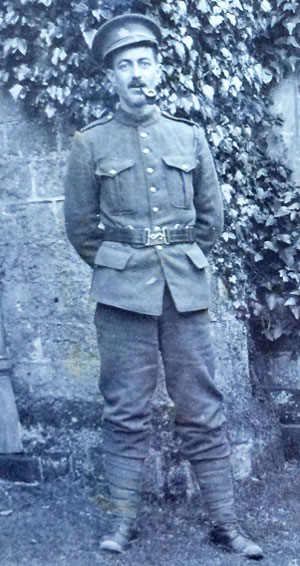
I had found him!
And could his brother William be the “Bill” mentioned on the Discovery postcard – or the “Bill” that Dick met at the station in Winnipeg?
The Grants of Nairn sold produce – a family member is listed as a “Fruiterer.” Living this close together and being of similar age and social status as Jack’s family, the Grants and McCurrachs would have had ample opportunity to know each other.
As immigrants in a new country, they would have maintained contact once in Canada. Ship’s records tell us that Dick travelled to Canada in March, 1912, arriving in Halifax on April 1 on the Scandinavian of the Allan Line. There is no evidence that any of his family came at the same time.
So there it was — the story, in broad strokes, of his life. He emigrated from Nairn, Scotland, and made his way to Discovery, B.C., a tiny, remote community 12 km from the equally tiny, remote community of Atlin, attempting to make his fortune in gold (he is the man in the hat in the two similar dog-sled images above).
His war records tell us that he was a member of the Duke of Connaught’s Own Regiment before he was transferred to the Vernon Mobilization Camp where he was assigned to the 47th Battalion. The battalion arrived in England on November 23, 1915 after ten days crossing the Atlantic, then embarked for France on August 10, 1916. His records also tell us that he was appointed Lance Corporal in November 1916 and that he was granted ten days’ leave of absence in December of 1916. He was promoted to Corporal in February, 1917.
The Canadian Army took Vimy Ridge on April 12th, 1917. But the engagement continued, and the next day, twenty-one men from the 47th battalion were killed in the intermittent shelling of the ridge by enemy heavy artillery.[9] This was the biggest day of losses for this battalion between April 9th and 13th, primarily because it had been in reserve for the main portion of the battle.

Dick Grant was one of those killed in action on April 13, 1917 on Vimy Ridge.
The Canadian Great War Project (canadiangreatwarproject.com) told me that Corporal Richard Grant was buried at the Petit-Vimy British Cemetery in France.
Simon Godly — who lives in the Vimy Region and runs www.webmatters.net — very kindly went to the Petit-Vimy Cemetery and took some pictures for me including one (below) of Richard Grant’s headstone.”
I had come full circle from knowing virtually nothing about Dick to knowing where he was born and where he died. It was extremely satisfying. But research is meant to enlighten more than one person, so when you find this kind of information, what do you do with it?
I felt it was important to see if I could contact any of Dick’s relatives. I sent a couple of messages via Ancestry.ca to members of what looked to be Dick’s family, and indeed, I found some of them.
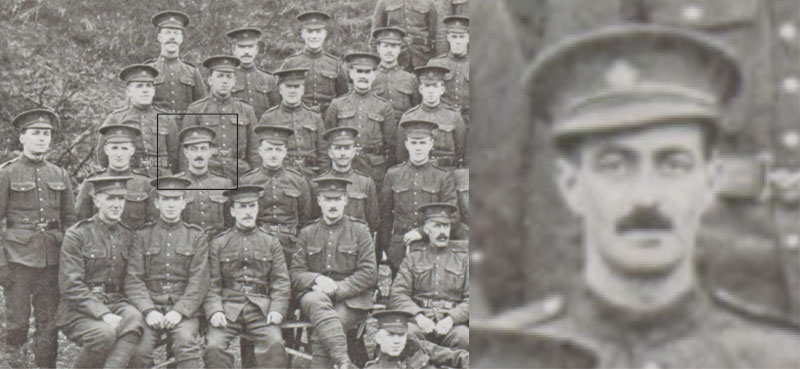
I visited Dick’s sister’s grandson and his wife two years ago at Easter. They live not far from where I grew up and where Dick went to summer training camp in the Okanagan Valley. They were excited to share some of their family treasures, and among them were some of the exact same postcards with Dick’s handwriting and signature on them. They were, of course, written to different people, but this correlation was very powerful.
There was absolutely no doubt now that Richard Grant was Dick. And here we were, nearly 100 years later, relatives of friends long gone visiting and talking about our families.
Another member of Dick’s family (descendant of another sister) actually lives in the same town as my parents, and last year I met her. She got in touch with some of her relatives, and they were able to find photographs of this man, so I could finally see Dick’s face.

One photo shows Dick Grant in Nairn before he immigrated to Canada. Written on the back is “Dick 1908.”
Another, showing “Uncle Dick” standing at left with two other men behind a “paper moon” – a photographer’s backdrop favoured in the early years of the twentieth century, possibly influenced by the visit of Halley’s Comet in 1910.[10] It might date from gold mining days.
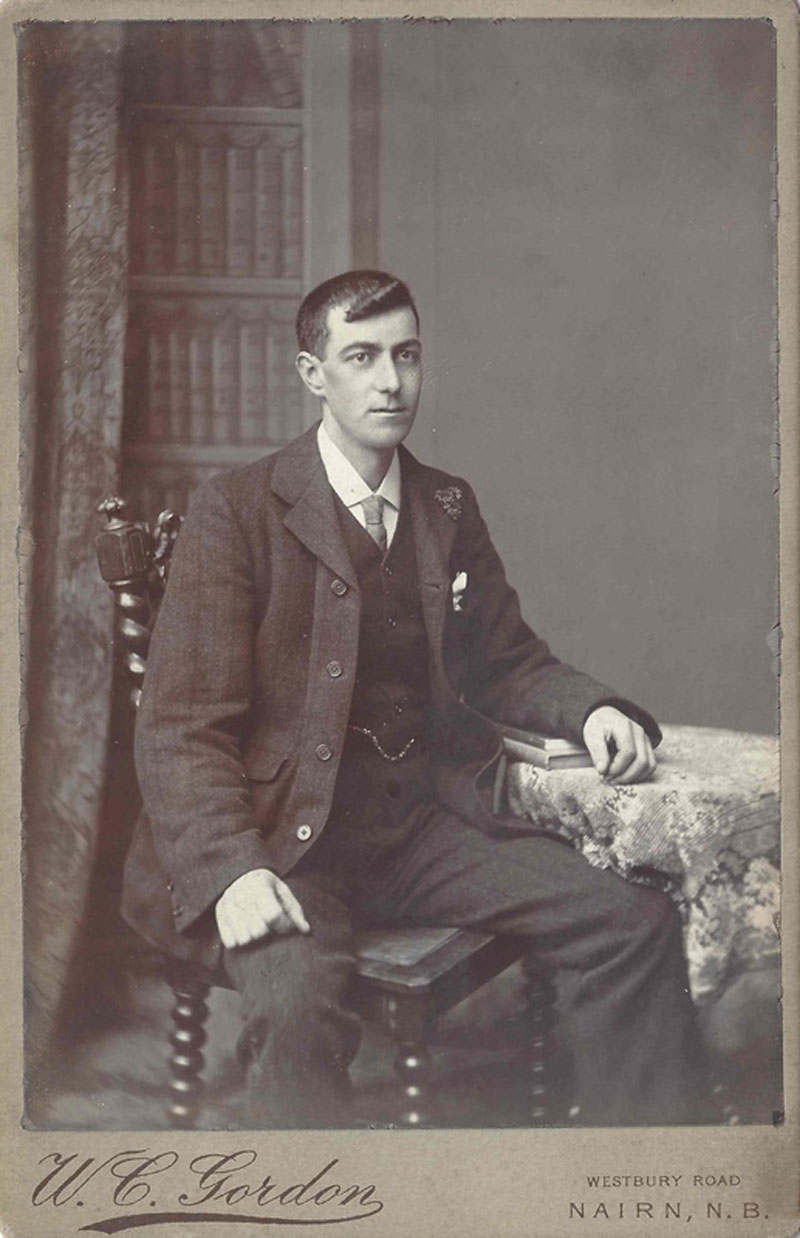
A third shows Dick in the army, on the left with the pipe and looking older.
I also found Dick in a 47th Battalion illustrated souvenir booklet at Library and Archives Canada.[11] He was part of Platoon 14. It was photographed, printed & Published by Gale & Polden, Ltd., Aldershot, England probably around the same time as the photo above (late 1915, early 1916 as the battalion disembarked in France on August 10, 1916).[12]
The family I met had not known Dick’s fate and didn’t even know what he had looked like until my research encouraged them to ask other relatives. He was a distant uncle with no wife and no children.
And now Richard Grant of Discovery, B.C., has been found. For a century after his death at Vimy Ridge, he had been lost to history and even to the memory of his family and friends who retained postcards signed solely by Dick, his familiar nickname.
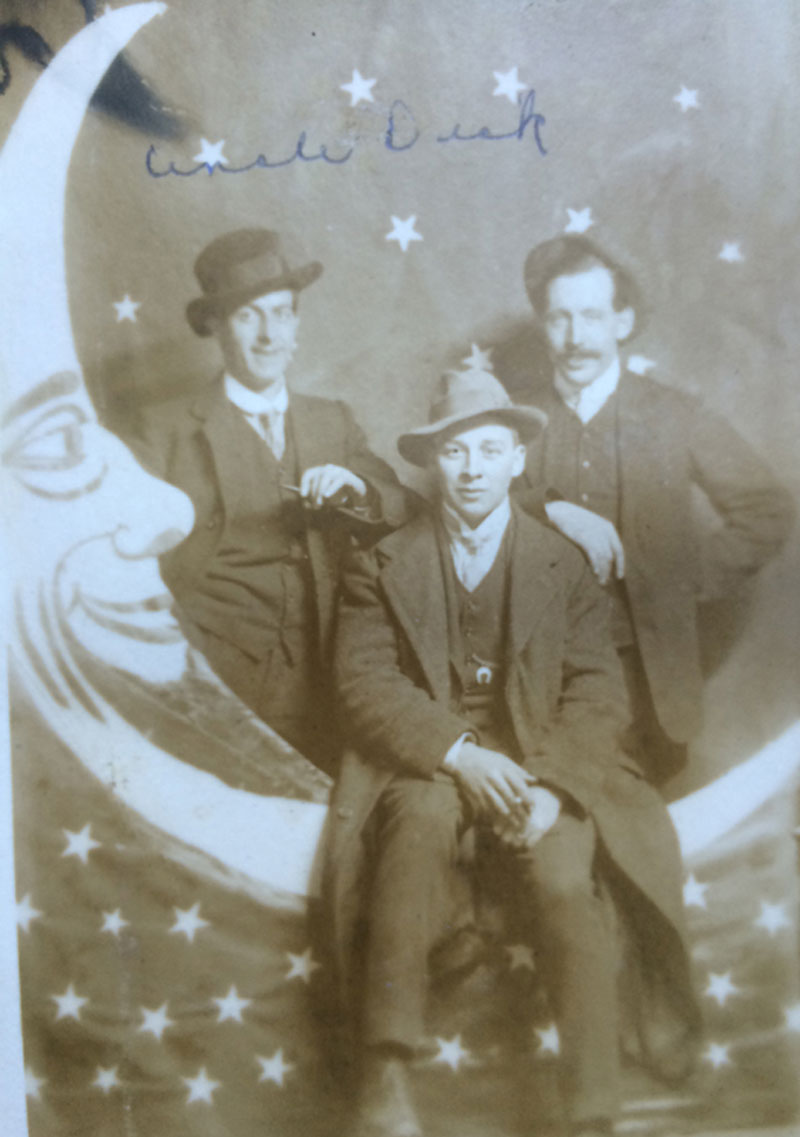
In the end, the brief words he communicated via postcards formed the vital material for his rediscovery.
It has been a pleasure finding him and sharing one of thousands of lives lost at Vimy Ridge.
[1] http://www.armycadethistory.com/vernon_acstc_main.htm (I haven’t been able to verify this population information, but I did find the 1918 Henderson’s City Directory, where the population is listed as 2,500).
[2] For Jack McCurrach’s military career, see Sandra Sauer Ratch, “‘Do Your Little Bit’: The 143rd Battalion Canadian Expeditionary Force, ‘BC Bantams,’” BC Studies 182 (Summer 2014), 151-176.
[3] For the Vernon camp, see Hugh Rayment and Patrick Sherlock, Camp Vernon: A Century of Canadian Military History (Vernon: Kettle Valley Publishing 2003), and James Wood, Militia Myths: Ideas of the Canadian Citizen Soldier, 1896-1921 (UBC Press, 2010).
[4] http://www.wikiwand.com/en/Bramshott_Camp
[5] Formed in 1914, the 47th Battalion (British Columbia) received numerous battle honours between the Battle of Mont Sorrel in June 1916 and the Battle of the Selle in October 1918. Disbanded in 1920, the 47th Battalion is perpetuated by the Royal Westminster Regiment. See Robert Harley, For King and Country: 150 Years of The Royal Westminster Regiment (New Westminster: Vivalogue, 2012).
[6] I also discovered the document that the Westminster Regiment undoubtedly used to compile the lists in For King and Country. See “Canadian Expeditionary Force 47th Battalion 1st, 2nd and 3rd Reinforcing Drafts Nominal Roll of Officers, Non-Commissioned Officers and Men,” Library and Archives Canada. Available online.
[7] http://www.collectionscanada.gc.ca/obj/001042/f2/Regimental_Number_List_of_the_Canadian_Expeditionary_Force.pdf
[8] See Christine Frances Dickinson and Diane Solie Smith, Atlin: The Story of British Columbia’s Last Gold Rush 1995 (Atlin: Atlin Historical Society: 1995).
[9] War Diaries for the 47th Battalion.
[10] See Rachel Kiernan, “Paper Moon,” https://rachelkiernan.com/2013/03/26/paper-moon/
[11] http://collectionscanada.gc.ca/pam_archives/index.php?fuseaction=genitem.displayItem&rec_nbr=4168315&lang=eng&rec_nbr_list=2004666,2005930,4168315,4229220,3771038,4250572,4280544,4223286,4226265,4248776
[12] Richard Grant (629491) war record.
*

Sandra Ratch is a heritage consultant with a Masters Degree in Archaeology from Simon Fraser University and over 25 years of experience in the heritage field. Having spent most of her life in British Columbia, she currently lives in Wetaskiwin, Alberta. The work presented here is to be included in a book based on a family postcard collection.
The Ormsby Review. More Readers. More Reviews. More Often.
Reviews Editor: Richard Mackie
Reviews Publisher: Alan Twigg
The Ormsby Review is hosted by Simon Fraser University. The Advisory Board consists of Jean Barman, Robin Fisher, Cole Harris, Wade Davis, Hugh Johnston, Patricia Roy, David Stouck, and Graeme Wynn.
—
BC BookWorld
ABCBookWorld
BCBookLook
BC BookAwards
The Literary Map of B.C.
The Ormsby Review
